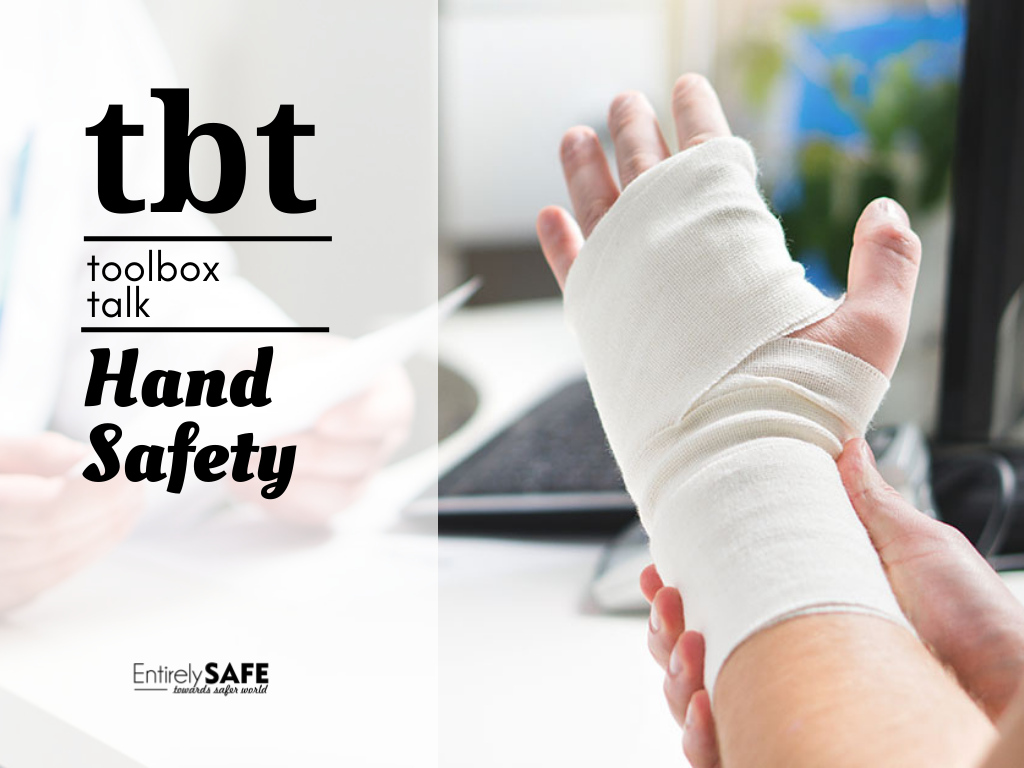Hand and Finger Safety Toolbox Talk

Before the Toolbox Talk
This safety talk is designed for discussion leaders to use in preparing safety meetings. Set a specific time and date for your safety meeting. Publicize your meeting so everyone involved will be sure to attend. Review this safety talk before the meeting and become familiar with its content.
Make notes about the points made in this talk that pertain to your workplace. You should be able to present the material in your own words and lead the discussion without reading it.
Seating space is not absolutely necessary, but arrangements should be made so that those attending can easily see and hear the presentation. Collect whatever materials and props you will need ahead of time. Try to use equipment in your workplace to demonstrate your points.
Give the safety talk in your own words. Use the printed talk merely as a guide. The purpose of a safety meeting is to initiate a discussion of safety problems and provide solutions to those problems. Encourage employees to discuss hazards or potential hazards they encounter on the job. Ask them to suggest ways to improve safety in their area. Don’t let the meeting turn into a gripe session about unrelated topics. As a discussion leader, it’s your job to make sure the topic is safe. Discussing other topics wastes time and can ruin the effectiveness of your safety meeting.

Toolbox Talk: Hand and Finger Safety
The capabilities of our hands and fingers place human beings above other animals.
Certain species of apes have hands, fingers, and thumbs, but no species can touch their little fingers with their thumbs. This simple fact sets us apart.
While our fingers are possibly the most used parts of our bodies, they are also the most mistreated.
It will be helpful to review a list of hand and finger safety precautions. Of course, we must realize that each job has its hazards, to a greater or lesser degree.
Let’s talk about those potentially dangerous situations in our jobs:
- Never put your hands or fingers on loads being moved mechanically without watching for pinch points and other potential hazards.
- Wear gloves only when there is exposure to hazards that could produce cuts or scrapes or to chemical hazards that could produce injuries or skin diseases. Do not wear them around reciprocating or rotating machine parts; gloves can be caught up, and fingers and hands can be pulled into the machine.
- Never use hands to stop rotating parts.
- Never use fingers to align holes in parts, like castings.
- Don’t wear rings on the job. Any jewelry can be dangerous.
- Use fuse removers to pull fuses, not your fingers.
- When lifting, check objects for protrusions, nails, splinters, screws, metal banding, or other sharp or pointed objects.
- Watch your fingers and hands when lowering heavy loads; they could get pinched.
- Adjust the grinder tool rests properly (no further than 1/8 inch away from the wheel) to avoid getting a finger into the gap or having the workpiece hurled at you or your co-workers.
- Never use your fingers to test the temperatures of gases, liquids, or solids.
Damage can happen before your reflexes remove your fingers.
- When handling large metal drums, watch out for pinch points and sharp edges; one drum can roll against another, catching your fingers in between.
- Handle very sharp or pointed tools, like hatchets, chisels, punches, awls, knives, and machine blades with extreme care.
Avoid using your fingers to fish out things lying near saw blades, knife blades, parts moving together, such as a punch press, rotating parts of drill bits, and reciprocating parts of in-running rolls, since this can be hazardous.
Of course, machinery parts should be guarded.
Interactive Discussion
- Have you or someone you know been injured or nearly injured while carrying out this activity? What happened?
- How can we stay safe today?
- What do we do at the worksite to prevent injuries related to this activity?
After the Toolbox Talk
At the end of the meeting, ask employees to sign a sheet on the back of this talk as a record that they attended the safety meeting. Keep this talk on file for your records.

